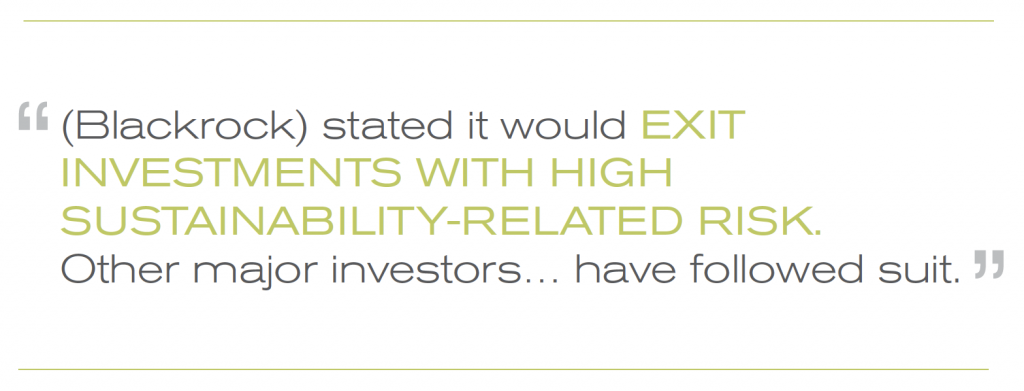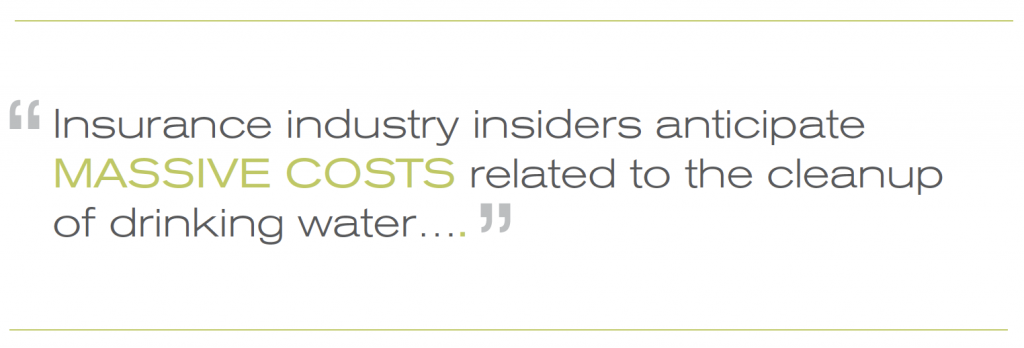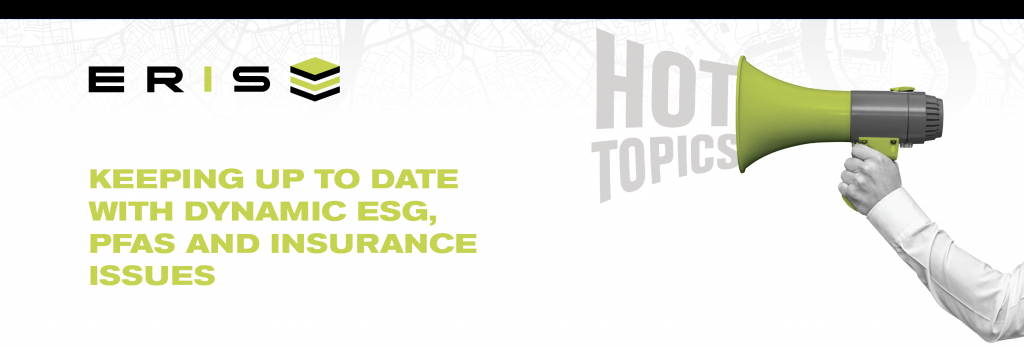Environmental Risk Hot Topics
by ERIS STAFF
April 16, 2020
As you navigate COVID-19-related challenges, while ensuring uninterrupted delivery of essential services to clients, several key emerging due diligence issues are having a major impact on our industry. This article will keep you up to date on where they stand today.
To say that 2020 has been a year of change is an understatement. Environmental risk assessment is also evolving with some rapidly emerging and important factors that can’t be ignored.
 Anyone involved in commercial real estate transactions routinely assesses a wide range of potential risks during environmental due diligence. It’s standard to evaluate historic and current property uses to identify contamination and other possible environmental liabilities. However, it’s vitally important to keep emerging issues on the radar, including new and unregulated risks that might not yet be “in scope” for routine environmental site assessments – and some of these emerging risk areas are poised to have a powerful impact on environmental due diligence.
Anyone involved in commercial real estate transactions routinely assesses a wide range of potential risks during environmental due diligence. It’s standard to evaluate historic and current property uses to identify contamination and other possible environmental liabilities. However, it’s vitally important to keep emerging issues on the radar, including new and unregulated risks that might not yet be “in scope” for routine environmental site assessments – and some of these emerging risk areas are poised to have a powerful impact on environmental due diligence.
The two emerging risks receiving widespread attention early in 2020 are: (1) climate and other risks related to environmental, social, governance (ESG) factors, and (2) per- and polyfluoroalkyl substances (PFAS). While these are wildly different issues, both have potentially far-reaching impacts that should be considered and integrated into any environmental due diligence and risk management strategy. Here’s an overview of where these issues stand today.
ESG Enters the Mainstream.
The ever-increasing scrutiny of ESG factors and related risks has been driven by several different forces including the investment community, consumers, and shareholders. There is now a growing set of common ESG metrics including overall carbon footprint, pollution emissions, natural resource and energy consumption, workforce diversity, supply chain, corporate ethics, and community impact.
 Sustainability Takes Center Stage. Earlier this year, BlackRock brought ESG mainstream when it announced that climate risk considerations would be front and center of its $7-trillion strategy. The company also vowed to make sustainability integral to its risk management strategy, and stated it would exit investments with high sustainability-related risk. Other major investors, such as StateStreet, have followed suit.
Sustainability Takes Center Stage. Earlier this year, BlackRock brought ESG mainstream when it announced that climate risk considerations would be front and center of its $7-trillion strategy. The company also vowed to make sustainability integral to its risk management strategy, and stated it would exit investments with high sustainability-related risk. Other major investors, such as StateStreet, have followed suit.
Ratings, Insurance Get on Board. Although investors have led the charge in the ESG arena, increased attention is also coming from insurers, financial institutions, rating agencies, and regulators. In fact, rating agencies such as Fitch are compiling ESG relevance scores and making them public. Insurers also are carefully evaluating climate and ESG risk and advise policyholders to do the same. In addition to ensuring coverage for the physical, structural damages from extreme weather events, parties also should assess whether they have adequate coverage for things like mold, as well as coverage for business interruption resulting from mold or other weather impacts. Although carbon emissions litigation has not succeeded to date, insurance experts predict a shift in climate litigation that might resemble product liability and market share litigation like that seen with MTBE. As that unfolds, parties will need to determine whether general liability pollution exclusions apply, and if so, assess whether they have other applicable policy coverage for such claims.
 Implications for Due Diligence. Driven by market demands for increased transparency, the ESG-risk analysis trend is expected to intensify. As such, all parties involved in property transactions would be wise to consider evaluating ESG factors, such as climate risk due to greenhouse gas emissions or flooding during extreme weather events, during due diligence. Doing so provides parties with an opportunity to identify, evaluate, and mitigate any risk factors that could: potentially give rise to statutory or third-party liability; affect the viability of real estate as long-term collateral; or impact the current price, future value, or anticipated use of the subject property or facility. ESG considerations are already routinely included in due diligence processes for mergers and acquisitions of businesses and assets.
Implications for Due Diligence. Driven by market demands for increased transparency, the ESG-risk analysis trend is expected to intensify. As such, all parties involved in property transactions would be wise to consider evaluating ESG factors, such as climate risk due to greenhouse gas emissions or flooding during extreme weather events, during due diligence. Doing so provides parties with an opportunity to identify, evaluate, and mitigate any risk factors that could: potentially give rise to statutory or third-party liability; affect the viability of real estate as long-term collateral; or impact the current price, future value, or anticipated use of the subject property or facility. ESG considerations are already routinely included in due diligence processes for mergers and acquisitions of businesses and assets.
ESG-Related Risk Categories. Bear in mind that ESG-related risks range from the direct physical risks (extreme weather, flooding, sea level rise), to transitional risks (emerging or changing regulatory schemes), to reputational risks (negative impacts on brand). Another emerging risk category relates to data and the need to verify the source and accuracy of data being used to make ESG risk determinations (think flood maps, compliance data, publicly reported data). Therefore, parties should assess this full range of ESG risk factors during due diligence.
The Fluorinated Chemicals Currently Known as PFAS
Sometimes called “forever chemicals,” PFAS are a group of man-made fluorinated chemicals manufactured and in use since the 1940s. (Note: ERIS covered PFAS in a feature article you can find here but it’s worth reviewing changes taking place now in 2020, in this rapidly evolving area.)
PFAS are used in nonstick, water repellant, and stain resistant consumer products such as food containers and fabrics, and other products, such as in fire-fighting foams. They’re ubiquitous and have made their way into drinking water supplies nationwide, accumulate in the human body, and are suspected to have significant adverse health effects. PFAS are the subject of significant legal actions against its manufacturers, including DuPont and 3M, with potential liability and nationwide cleanup costs estimated in the billions.
While thousands of chemicals are classified as PFAS, the two primary chemicals of immediate concern are PFOA and PFOS. Found in both soil and groundwater, the U.S. Environmental Protection Agency issued drinking water advisory levels in 2016 for PFAS and PFOA of 70 parts per trillion (ppt) and has issued a PFAS Action Plan (February 2019), but there currently are no actionable federal standards.
Regulatory Patchwork Emerging for PFAS. Driven by the lack of enforceable nationwide standards and public concern about the health effects of PFAS, states have started promulgating their own PFAS regulations and policies, varying widely in their approaches. New Jersey, for example, has set interim groundwater quality standards at 10 ppt for PFOA and PFOS. This resulting patchwork of changing and inconsistent compliance obligations will make it challenging for companies to accurately categorize, estimate, and manage PFAS risks and associated costs. EPA continues to move forward with PFAS policy and regulatory activities. In December 2019, EPA issued interim guidance for addressing groundwater contaminated with PFOA and PFOS, recommending screening levels of 40 ppt to determine if those substances are present at a site and might warrant further attention.
In February, EPA updated its PFAS action plan, which details the status of various activities including the agency’s proposal to regulate PFOA and PFOS under the Safe Drinking Water Act, and its continued work to designate PFOA and PFOS as hazardous substances under the Comprehensive Environmental Response, Compensation, and Liability Act.
PFAS under CERLCA. Designating any PFAS as a CERCLA hazardous substance would be a game changer, with an immediate and significant impact on commercial real estate transactions. Under CERCLA’s liability scheme, both current and former owners and operators of any PFAS-contaminated property could potentially be on the hook for the entire cleanup, without regard to fault. PFAS cleanup liability would extend far beyond the chemical manufacturers.
 Because PFAS is not currently regulated as a CERCLA hazardous substance, it is not yet “in scope” under ASTM’s E1527 Phase I standard. But in light of litigation concerns, the existence of state regulation, and emerging federal regulation, parties should consider including PFAS as a non-scope item in their Phase Is, and take the necessary steps to qualify for CERCLA’s bona-fide prospective purchaser defense to ensure their statutory protection while regulatory policies are in flux. ASTM is currently revising E1527 with an expected publication date in 2021.
Because PFAS is not currently regulated as a CERCLA hazardous substance, it is not yet “in scope” under ASTM’s E1527 Phase I standard. But in light of litigation concerns, the existence of state regulation, and emerging federal regulation, parties should consider including PFAS as a non-scope item in their Phase Is, and take the necessary steps to qualify for CERCLA’s bona-fide prospective purchaser defense to ensure their statutory protection while regulatory policies are in flux. ASTM is currently revising E1527 with an expected publication date in 2021.
Currently, there is no plan to include PFAS as an “in scope” item in the revised standard, but this would shift if PFOA, PFOS, or any PFAS are designated as CERLCA hazardous substances.
PFAS Risk Situation is Unprecedented. Not surprisingly, the environmental insurance industry is also tracking developments related to a variety of emerging contaminants, such as PFAS and 1,4-dioxane. PFAS, however, is in a league of its own: it has widespread impact, is relevant across all industries, and everyone can have potential exposure.
 Adding to the PFAS perfect storm is the public concern and fear that is driving faced-pace regulatory change and unprecedented regulatory limits in parts per trillion. Insurance industry insiders anticipate massive costs related to the cleanup of drinking water as well as the reopening of legacy sites that will require further cleanup. They also warn that defense costs in PFAS cases will surge.
Adding to the PFAS perfect storm is the public concern and fear that is driving faced-pace regulatory change and unprecedented regulatory limits in parts per trillion. Insurance industry insiders anticipate massive costs related to the cleanup of drinking water as well as the reopening of legacy sites that will require further cleanup. They also warn that defense costs in PFAS cases will surge.
While coverage can still be underwritten, this is an emerging field in claims and litigation with regulatory change and reopeners that will drive underwriting scrutiny and impact policy availability. It’s an area all due diligence professionals should be following closely. We’ll do our best to keep you up to date.


